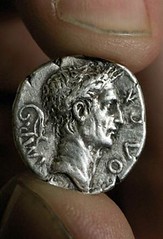
PREV ARTICLE
NEXT ARTICLE
FULL ISSUE
PREV FULL ISSUE
MORE ON THE FORGED ROMAN SILVER DENARIUS
Via the Explorator newsletter comes this link to an article with more information on the counterfeit "Del Boy" Roman coin discussed a couple weeks ago. Here are some excerpts.
-Editor
Experts at the British Museum say the coin is a mystery because it is made from solid silver and probably cost the forger as much to make as he received in profit. The silver denarius, an average day's pay for a Roman worker, is based on coins struck to commemorate the Battle of Actium between Octavian and the combined forces of Mark Antony and Cleopatra in 31 BC. But the forger got most of his inscriptions wrong. He crafted his denarius some years after the battle but had a poor memory of what the real coin looked like. On one side is a crocodile but it is facing the wrong way. On the other side is the head of Julius Caesar when it should have been the his nephew the Emperor Augustus. An examination using the university's new state-of-the-art electron microscope, the most advanced in the south east, showed the coin's content is solid silver. Rob registered the find with Laura Burnett, finds liaison officer for Sussex, who sent photos of the coin to the British Museum. Sam Moorhead, national finds adviser for Ancient Coins at the British Museum, said the poor spelling "suggests the die cutter is not fully literate" and he said he was baffled why the forger bothered in the first place. He said: "Interpreting the coin is difficult. Were it a (silver) plated piece, then it would have been explicable as an attempt to create a coin for profit by using a smaller amount of silver. "However, why would someone create a fantasy piece like this in the ancient period from solid silver? As such, the coin is a mystery." However Diarmaid Walshe a PhD researcher at the nearby University of Sussex has a theory, "Could we be looking at early form of money laundering?". Its possible the forger had come into the possession of sliver which might have been acquired illegitimately and the forger wanted to hide this. A classic way to convert hot or stolen property is to use methods that can clean it up and so camouflages its illegal origins. By converting the metal into coin form it would have in todays terms, "laundered it" and would have made it difficult to have traced it original source. In this way forger could have used the coins as currency which goes some way to to explain the mystery"
To read the complete article, see:
The mystery of a forged coin and money laundering?
(www.archnews.co.uk/featured/3859-the-mystery
To read the earlier E-Sylum article, see:
METAL DETECTORIST FINDS UNUSUAL COUNTERFEIT ROMAN COIN
(www.coinbooks.org/esylum_v13n45a19.html)
The Numismatic Bibliomania Society is a non-profit organization promoting numismatic literature. See our web site at coinbooks.org. To submit items for publication in The E-Sylum, write to the Editor at this address: whomren@gmail.com To subscribe go to: https://my.binhost.com/lists/listinfo/esylum All Rights Reserved. NBS Home Page Contact the NBS webmaster 
|
